
WPA GUIDES OF THE 1930s
❖❖❖
IN THIS ISSUE
EATING AROUND WALT DISNEY WORLD
By John Mariani
NEW YORK CORNER
IL MONELLO
By John Mariani
GOING AFTER HARRY LIME
CHAPTER TWO
By John Mariani
NOTES FROM THE WINE CELLAR
DOMAINE DE LA RIVIÈRE
By GEOFF KALISH
❖❖❖
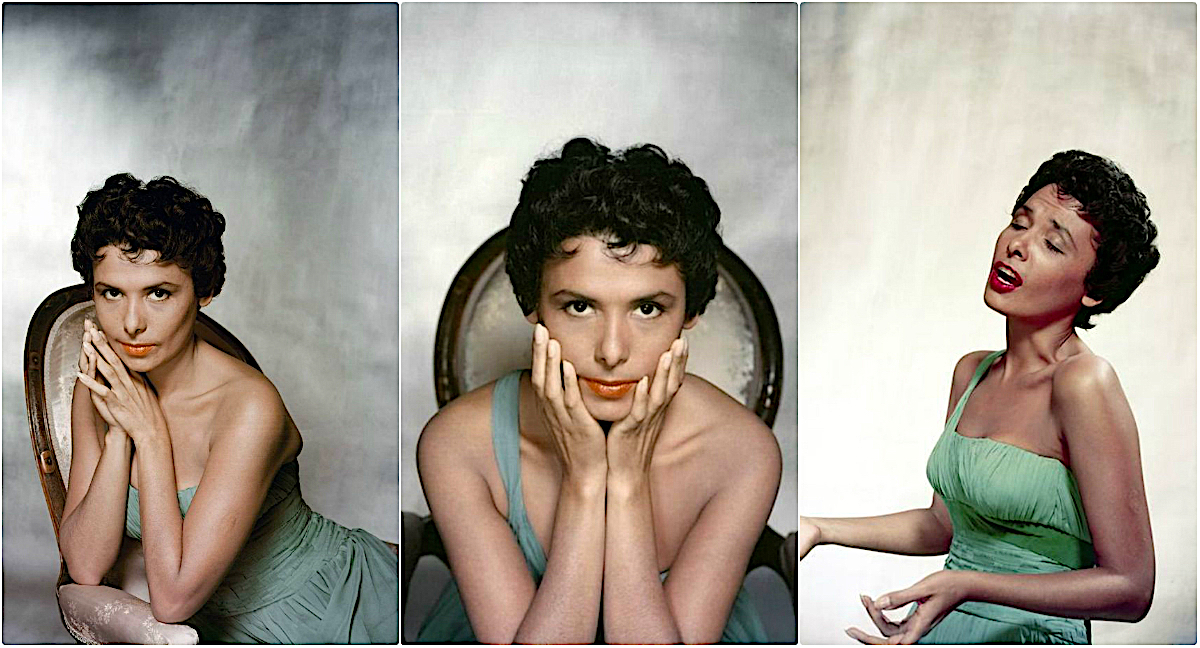 Gavin,
biographer of entertainer LENA HORNE.
Go to: WVOX.com.
The episode will also be archived at: almostgolden.
Gavin,
biographer of entertainer LENA HORNE.
Go to: WVOX.com.
The episode will also be archived at: almostgolden.
❖❖❖
EATING AROUND WALT DISNEY WORLD RESORT
Part One
By John Mariani
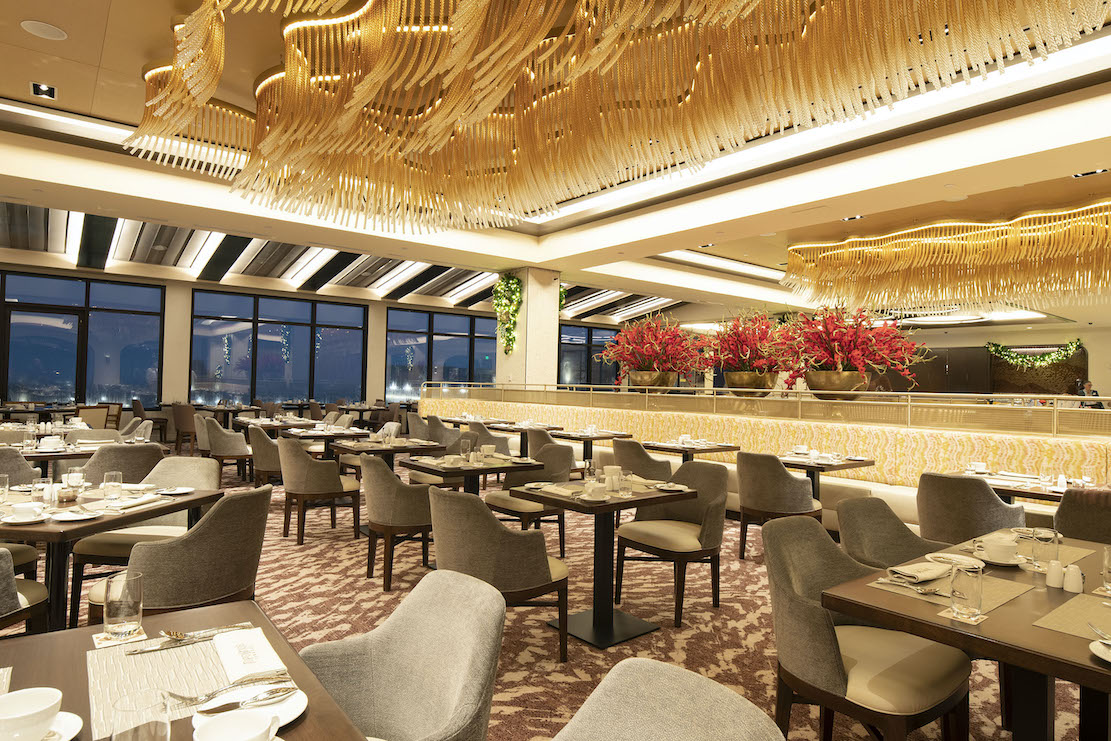
Topolino's
More than once before I went on a
recent trip to Walt
Disney World Resort in Florida was I asked by
naïve friends, “Why?” When I replied
that I was going to check out the restaurants,
my inquirers—none of whom had
been to Disney in Lake Buena Vista or Disneyland
in Anaheim since they had young children or
perhaps
ever—looked dumbfounded, assuming that all food
service at those resorts was
geared either to small fry or so tied to a
“theme” that a good adult restaurant
was impossible to find.
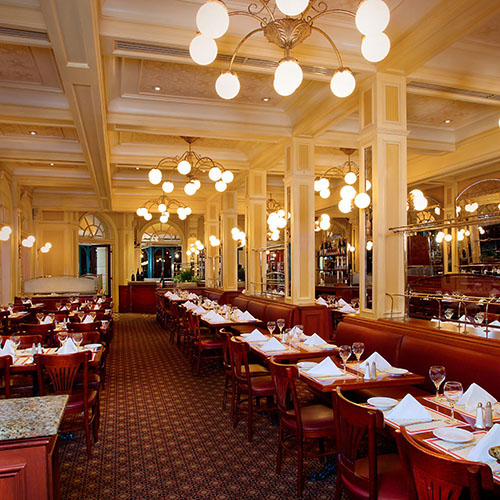 That
myopic view hasn’t been vaguely true for more than
fifty years, and as someone who, at the
age of 10, went to Disneyland the year it opened
in 1955 and many times to Walt Disney World
Resort, which opened in Lake Buena Vista,
Florida, in 1971, I’ve seen the evolution of
food service from being good,
wholesome and basic to extraordinarily
sophisticated and well worth a trip for
anyone who also intends to stay at some grandly
conceived resorts, swim, play
golf and relax, with or without kids in tow. In
fact, few restaurants in the
city of Orlando or Miami would compare well with
the best at Disney.
That
myopic view hasn’t been vaguely true for more than
fifty years, and as someone who, at the
age of 10, went to Disneyland the year it opened
in 1955 and many times to Walt Disney World
Resort, which opened in Lake Buena Vista,
Florida, in 1971, I’ve seen the evolution of
food service from being good,
wholesome and basic to extraordinarily
sophisticated and well worth a trip for
anyone who also intends to stay at some grandly
conceived resorts, swim, play
golf and relax, with or without kids in tow. In
fact, few restaurants in the
city of Orlando or Miami would compare well with
the best at Disney.
Food service got serious at Disney with
the opening of the international pavilions at
EPCOT Centre in 1982, by
contracting established master restaurateurs like
Paul Bocuse, Roger Vergé and
Claude Troisgros to open two French restaurants on
the property (left), along with
other outside professionals to open the Italian
Alfredo the Original of Rome,
Chinese Nine Dragons and Moroccan Marrakesh.
In addition, themed restaurants like
The Hollywood Brown Derby at Disney-MGM Studios
(now Disney’s Hollywood
Studios) and some highly innovative restaurants in
the hotels and resorts—like
the California Grill at Disney's Contemporary
Resort and Victoria and Albert’s
at Disney’s Grand Floridian Resort & Spa—were
directly aimed at the
hundreds of thousands of adults who want more than
burgers and pizza after
spending $109 to $189 for a one-day pass.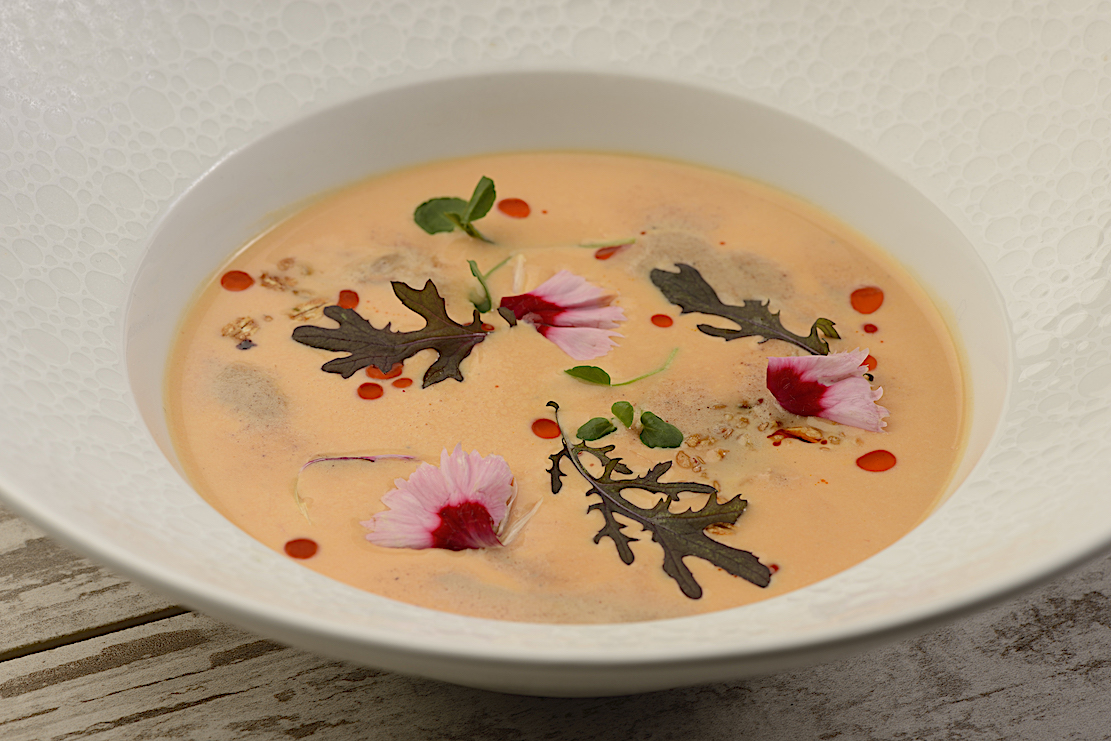
Since then Disney has opened more than
500 food service units, including Broadway Joe’s
Marvelous Margaritas ($15) on
the boardwalk. And, because of its enormous clout
in the market and the rigors
of its health rules, Disney can order the finest,
most consistent meat, seafood
and provender in the global market. That goes for
stocking wine cellars, with a
few of the resort hotel restaurants having
award-winning wine lists that would
rival the best in any U.S. restaurant. EPCOT
Centre’s annual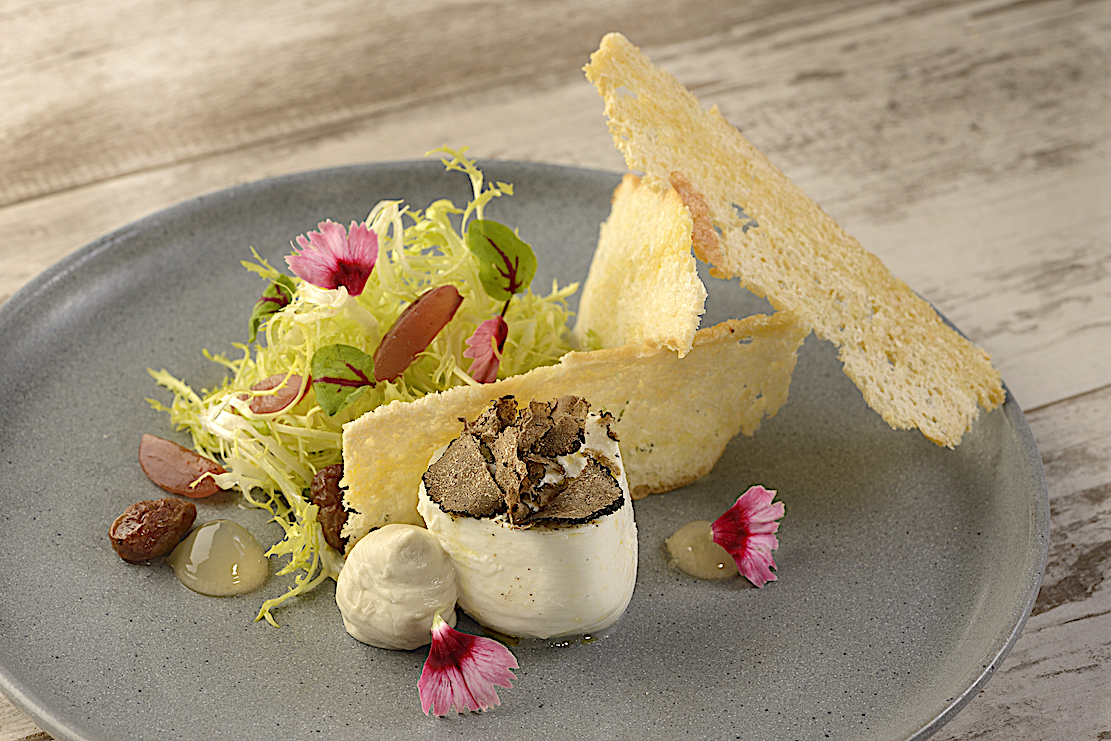 International Food
Menu is one of the most extensive and popular in
the state.
International Food
Menu is one of the most extensive and popular in
the state.
Food prices are also comparable with
upscale restaurants in Florida, although in décor and
sight lines alone, which include a nightly
fireworks show, you get a lot more bang for the
buck at Disney.
On my three-day trip, then, I sought
to go back to some established restaurants—which
are always being refreshed or
re-imagined—and some, post-Covid, new ones.
Of the latter is Topolino’s Terrace
in
the Riviera Resort, so called after Italians’ name
for Mickey Mouse, though
there is nothing to remind you of the character in
the dining room. The menu
focuses on the cuisine of the French and Italian
Riviera, overseen by veteran
chef Dominique Filoni, whose work I’ve known since
he had his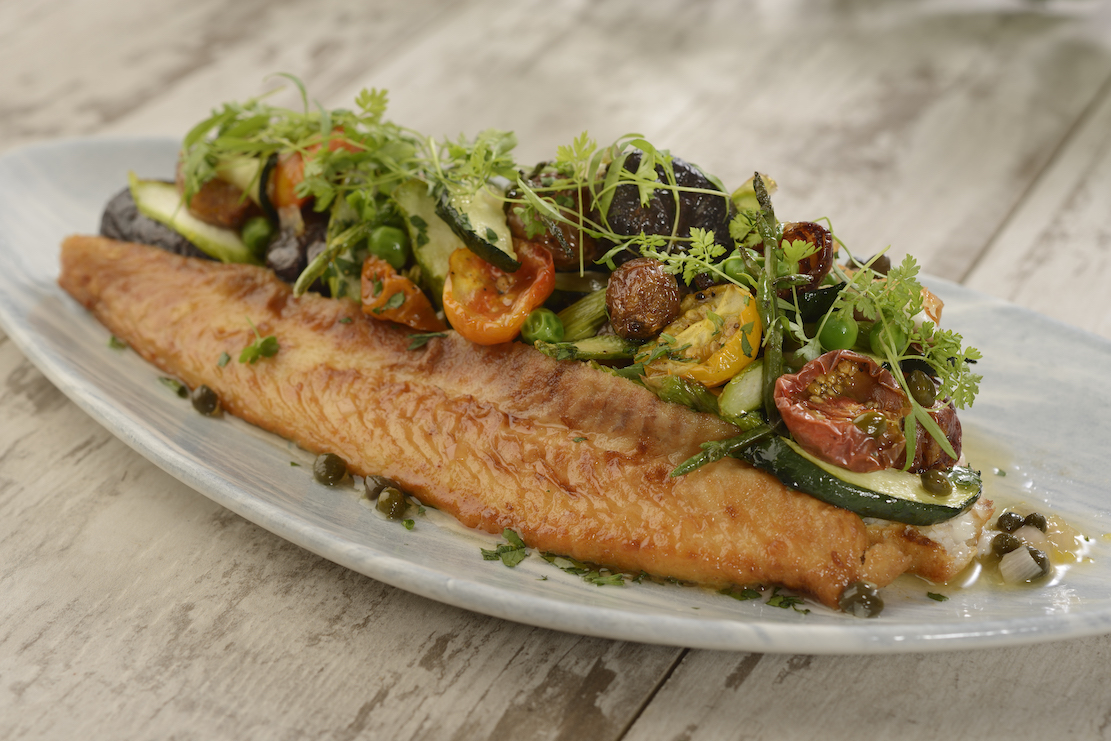 own Mediterranean
restaurant outside of Philadelphia years ago.
own Mediterranean
restaurant outside of Philadelphia years ago.
The spacious dining room’s décor is
done largely in browns, taupe and gold colors,
with a huge shimmering
chandelier, though the lighting needs to be
brought up on the bare brown tables
to show off the beauty of the food.
Among the starters is a
house-made creamy burrata (above, left)
with black
truffle, artichokes, grapes, verjus
gel and yeasty, warm focaccia ($12). Impeccably
fried fritto misto includes artichokes,
clamshell mushrooms and zucchini
with an herbed emulsion and a tangy-sweet golden
raisins mostarda conserve ($12 ).
Outstanding was red kuri squash soup (above,
right) I
had owing to its out-of-the-ordinary flavors like
espresso, annatto and dried
fruit granola for texture ($14 ). Luscious,
slow-roasted octopus comes out very
tender with a soffritto,
crispy
polenta-like panisse, saffron aïoli, roasted
garlic and a touch of mint ($19.)
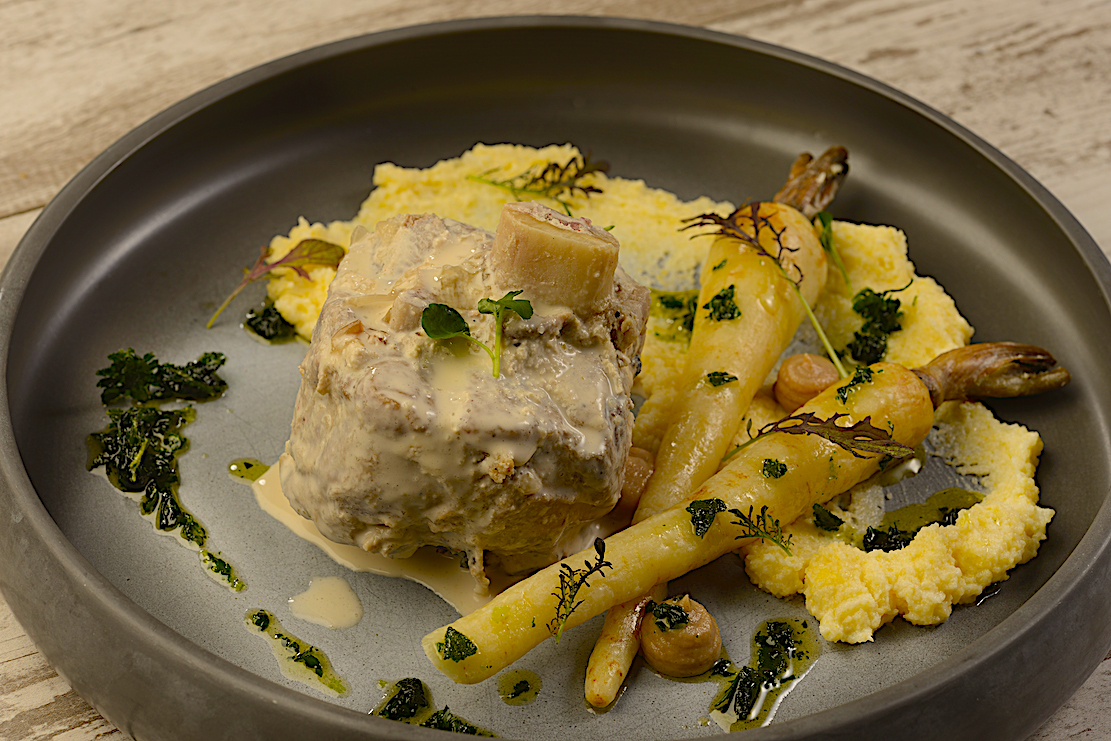 Pastas are all delicious and come in
ample portions. Plump but light gnocchi was
lavished with rich braised lamb
shoulder ragù, mushrooms, red wine reduction and
sweet carrots ($18). Rigatoni
comes with a braised chicken sugo,
broccolini, pancetta and wild mushrooms ($34).
Lobster is impeccably cooked to
retain its moisture and gains sweetness from
English peas and rich, creamy sauce
américaine with pickled
onions and a tuile colored with squid
ink, all atop linguine ($52).
Pastas are all delicious and come in
ample portions. Plump but light gnocchi was
lavished with rich braised lamb
shoulder ragù, mushrooms, red wine reduction and
sweet carrots ($18). Rigatoni
comes with a braised chicken sugo,
broccolini, pancetta and wild mushrooms ($34).
Lobster is impeccably cooked to
retain its moisture and gains sweetness from
English peas and rich, creamy sauce
américaine with pickled
onions and a tuile colored with squid
ink, all atop linguine ($52).
Among the main courses the sole
meunière (above) is a bargain at $50,
if a bit overelaborated with sea beans, capers,
asparagus, English peas, toybox tomatoes and
roasted potatoes that detract from
the classic simplicity of the dish. A massive veal
chop had a slightly smoky
flavor, with whipped potatoes, pommes fondant
cooked with its juices, baby
turnips, and a Sicilian salsa verde
($53), 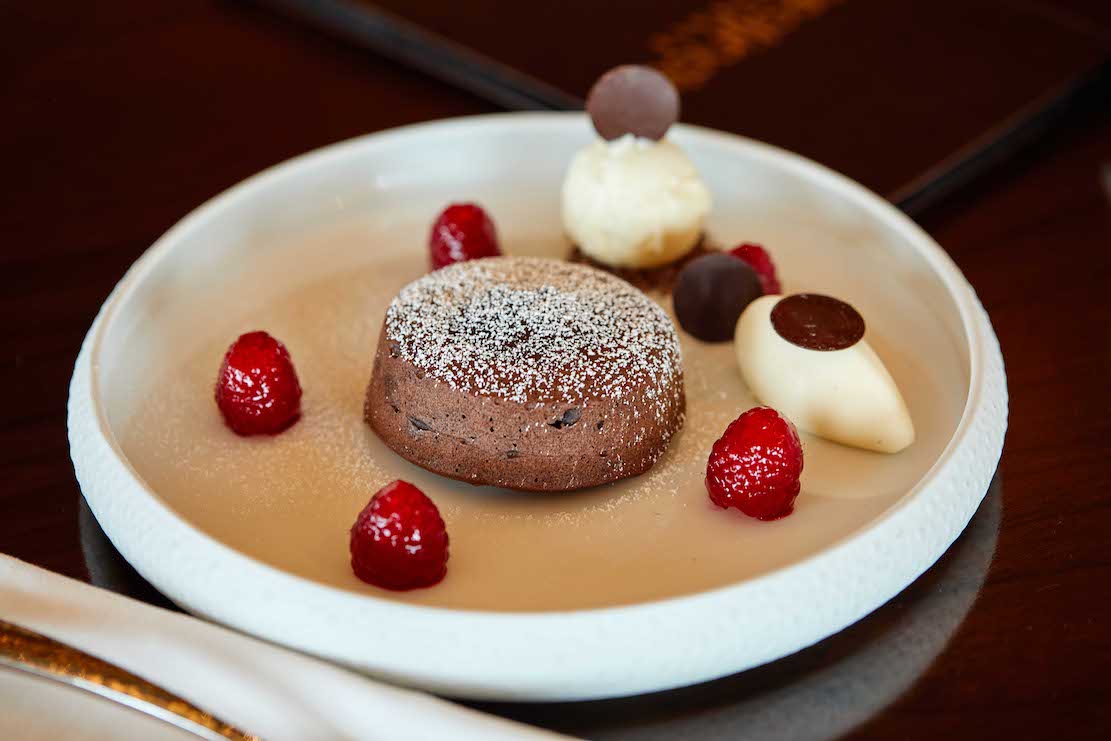 while
the pork shank blanquette (above) with
parsnips, polenta, apple butter and
chimichurri was a dazzlement of gusty flavors
($46). I had some of the best sea
scallops in a while at Topolino’s, with butternut
squash risotto, root
vegetable crackers and cioppino jus
($52).
That most Provencal of all
dishes, bouillabaisse ($48) teemed with morsels of
red snapper, branzino,
clams, shrimps and mussels in a reduction of
fennel and a saffron rouille.
while
the pork shank blanquette (above) with
parsnips, polenta, apple butter and
chimichurri was a dazzlement of gusty flavors
($46). I had some of the best sea
scallops in a while at Topolino’s, with butternut
squash risotto, root
vegetable crackers and cioppino jus
($52).
That most Provencal of all
dishes, bouillabaisse ($48) teemed with morsels of
red snapper, branzino,
clams, shrimps and mussels in a reduction of
fennel and a saffron rouille.
There
is a cheeseboard of international
selections served with honeycomb,
figs,
mushroom conserve and Marcona almonds ($21), and
the desserts are requisite to
share, like vanilla and citrus crème brûlée with
morello cherry compote,
strawberry foam, sugared beignets, and chocolate
meringues ($14) and the warm
chocolate cake (right) with a caramel
center, Chantilly cream and raspberries ($15).
Like many Disney restaurants, Topolino’s
features a Disney character breakfast ($49 for
adults, $29 for children).
Recast
from what had been a
Mediterranean restaurant, Citricos in the
Grand Floridian Resort is now more
eclectic. And, despite its name, the
theme here is from the film Mary Poppins
Returns, with the backs
of
dining chairs and server stations done with sprays
of cherry blossoms, for
Cherry Tree Lane, while the chairs in the lounges
are configured like Mary’s
corset. Birds perch in the light fixtures, and the
floral pattern in the rug is
from Mary Poppins’s carpetbag in the original 1964
movie. There is also a
painting of Cherry Tree Lane, where the Banks
family resides in both films.
Inside the private Sommelier Room you can see the
real carpetbag and Polly, her
iconic umbrella, on display.
Chef Andres Mendoza works out of a big,
brightly lighted open kitchen to produce
a splendid and very balanced menu that begins with
appetizers like
rice balls called arancini studded with wild
mushrooms, with
a truffle aïoli and Champagne
vinaigrette ($16).
Compressed star fruit, Thai passion fruit nuoc cham and
a blood orange
puff tapioca underpinning full flavored
citrus cured hamachi ($21,) while Berkshire
pork belly comes with boniato and plantains
croquette, salsa Verde and jicama ($18).
The entrees have a hard-to-choose-among
range. Both seafood dishes are very good— Golden
tile fish with juniper rice
and chorizo-flecked risotto, fresh Key West pink
shrimp and a tomato confit
($46), and
a butter-poached
Florida
mahi-mahi with mashed fingerling potatoes, grilled
asparagus, local mushrooms
and a beurre blanc tinged with grapefruit ($42).
On the carnivore side there is
guava-slathered barbecued short ribs with creamy
cheddar cheese grits, and
roasted poblano chile. The only disappointment was
an overly lavish plate of
rigatoni bolognese with seasonal vegetables, hen
of the woods mushrooms, and a
bland vegan “egg yolk” ($15). But you should try
the side dish of truffled mac
& cheese made with house-made gnocchetti,
black truffles and a sprinkling
of tarragon
($21). By
the way, wine suggestions (extra) are
listed with each main course.
Pastry Chef Kristine Farmer’s desserts
match the other courses, including an orange
blossom flan with blood orange
jelly, orange-scented shortbread and orange
blossom honey ($13); an apple rose
served with marzipan, raspberry jam and frozen
coconut milk ($13);
and a chocolate torte financier with a dark
chocolate ganache, Morello cherry and
vanilla mascarpone cream ($14).
The wine list has fifty-plus
selections, heaviest in reds, and mark-ups are
somewhat lower than you’ll find
elsewhere in Florida’s fine dining restaurants.
Surprising, then, that none
have vintages listed, which are “subject to
change.”
Just reading the menu
descriptions and seeing the photos here of
Topolino’s and Citricos gives you a sense of
Disney's range when it come to
upscale dining. But in the execution there are few
to rival them in the South.
❖❖❖
337 E 49th Street
917-675-7491
By John Mariani
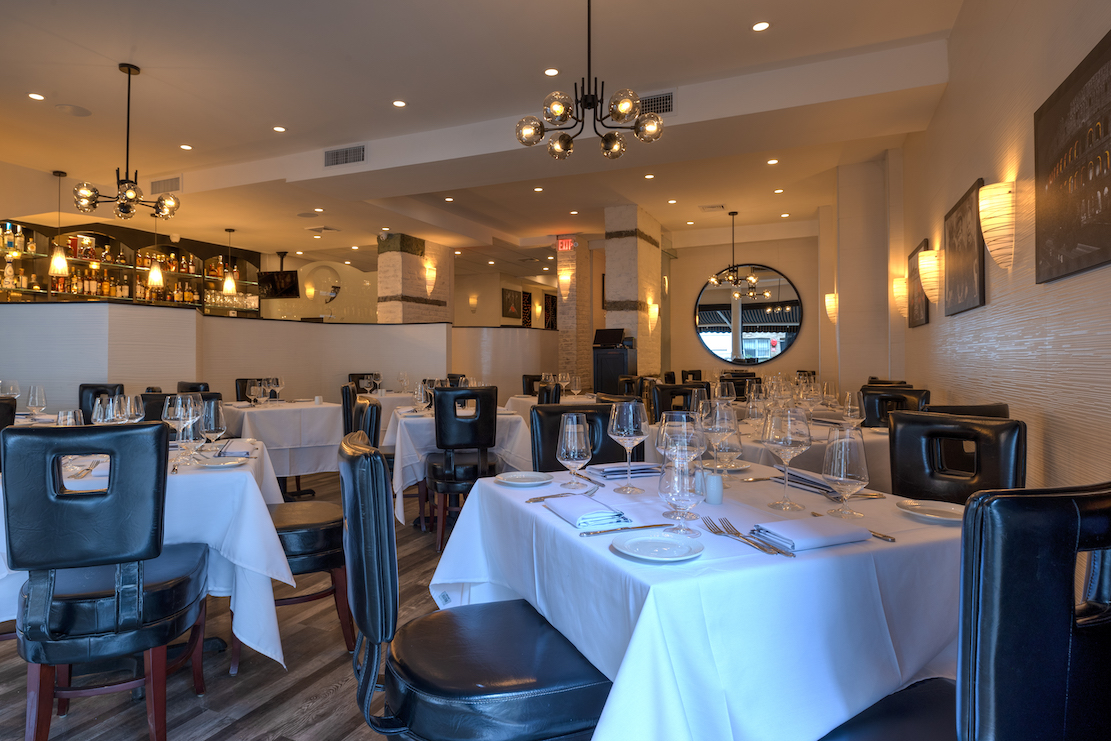
Back in
the 1970s a slew of Italian
restaurants opened on Manhattan’s East Side
that elevated the cuisine and décor
well above the Italian-American model of the
past. Two of those were Il Monello
(1974) and Il Nido (1979), stylish ristoranti
opened by Tuscan-born Adi Giovanetti, who
introduced a sophisticated service,
many dishes never served in New York before
and had a wine list of the best
Italian wines then coming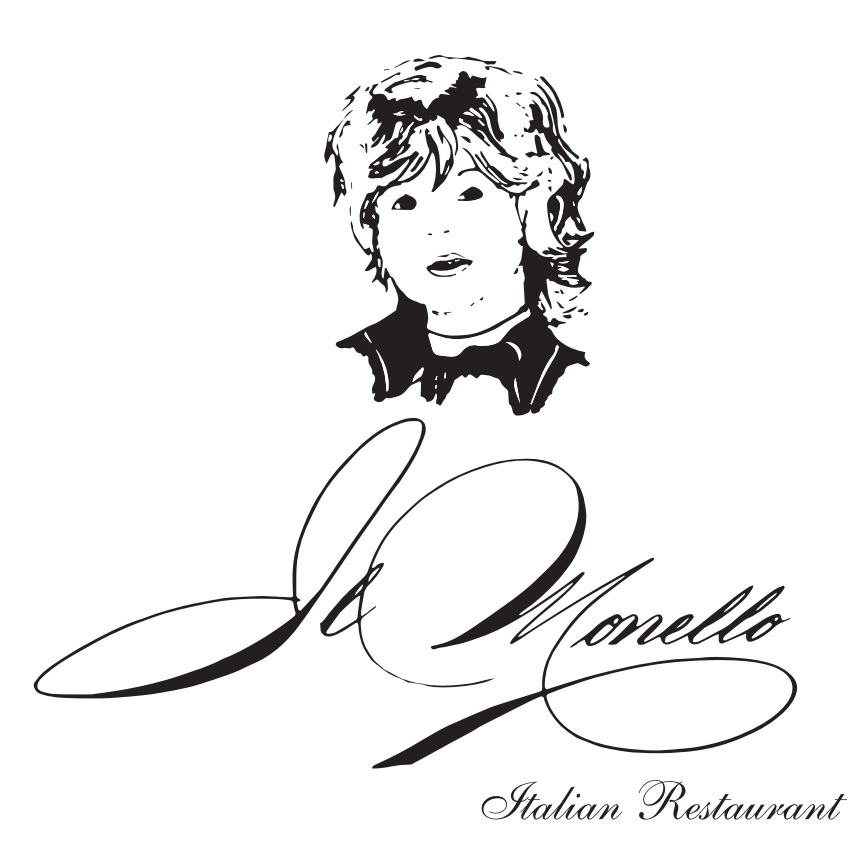 into the country.
into the country.
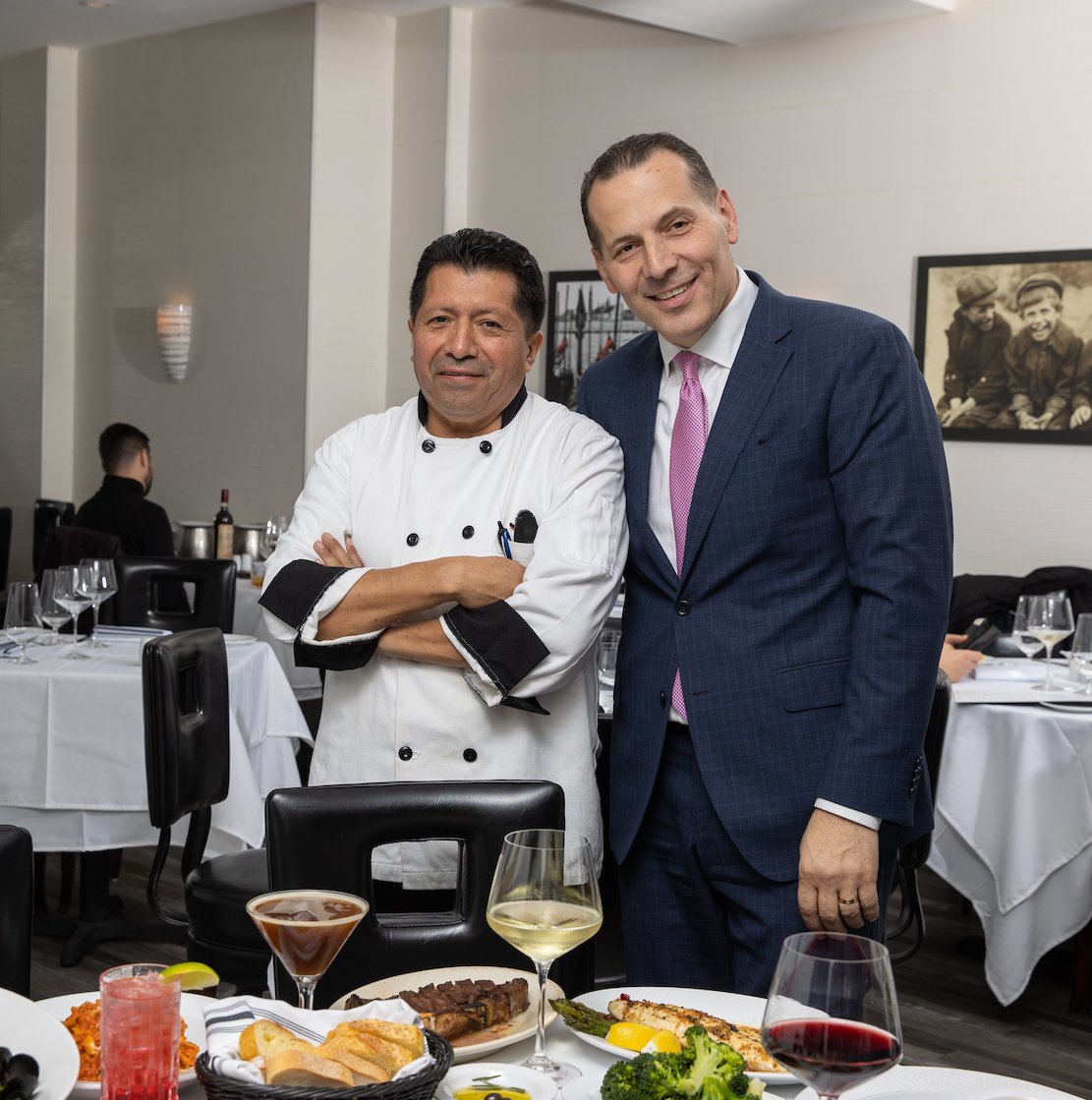 Il Monello—the
name means “little
rascal”—then on 76th Street and Second Avenue,
closed, re-opened and then was
sold to Steve Haxhiaj, who had worked for
Giovanetti, but shuttered again in
2008. (Il
Nido closed a few years later;
Giovanetti passed away soon after.)
Il Monello—the
name means “little
rascal”—then on 76th Street and Second Avenue,
closed, re-opened and then was
sold to Steve Haxhiaj, who had worked for
Giovanetti, but shuttered again in
2008. (Il
Nido closed a few years later;
Giovanetti passed away soon after.)
Now re-opened at a different
location by Haxhiaj and chef-partner Jaime Chabla, Il
Monello has the same soft luxury of the
original, though in a more modern
décor. The
lighting is finely modulated,
helped by small lamps that throw a glow onto the
white tablecloths.
The front window faces the street, and
there is a handsome bar as you enter. There are
120 seats, but the
well-separated tables, with comfortable leather
chairs, make it appear smaller,
 more
intimate. The sound level in the room is ideal,
perhaps because Il Monello
draws a crowd that does not shout to be heard
nor need to.
more
intimate. The sound level in the room is ideal,
perhaps because Il Monello
draws a crowd that does not shout to be heard
nor need to.
The menu fits on one broadside and
is well balanced in categories that begin with
salads, and the one to share is
the Il Monello of baby arugula, goat’s cheese,
shaved pears, seedless grapes,
toasted almond flakes and a lemon truffle oil
dressing ($14).
Among the
antipasti the stand-out is
the eggplant parmigiana ($19), a hefty square
whose lavish tomato and
mozzarella cheese looks as delectable as a Wayne
Thiebaud still life (right). Tender
Littleneck clams are gently dressed with moist
breadcrumbs and fresh oregano
($18).
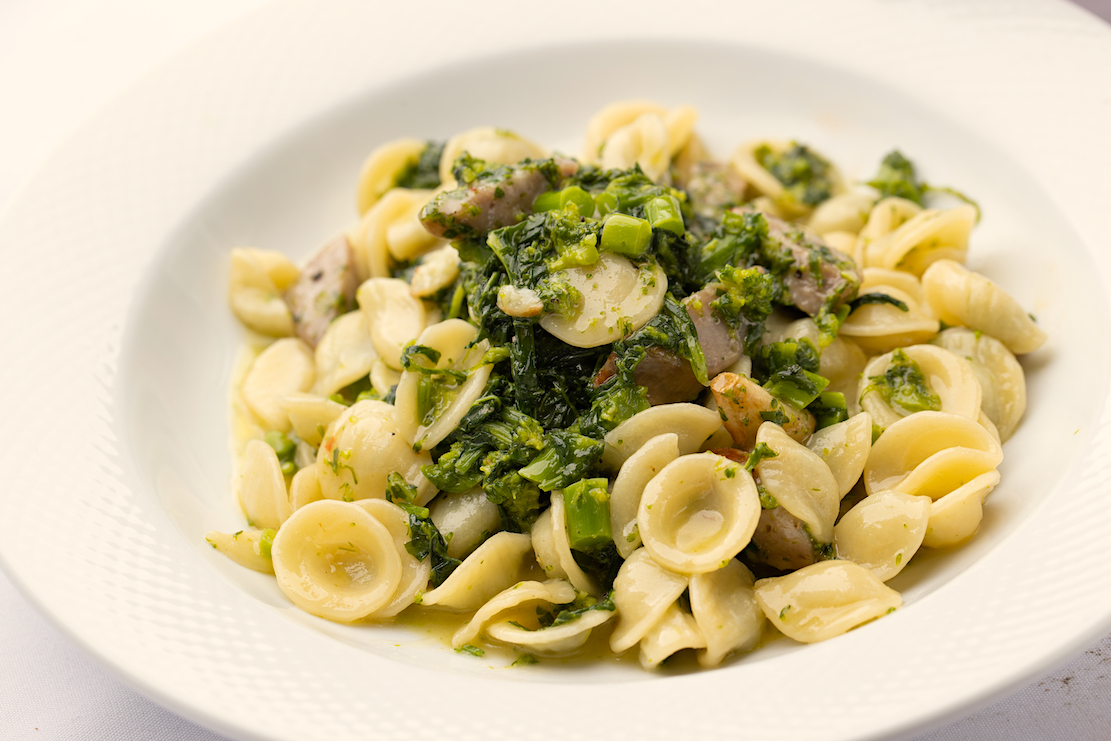 There
are six pastas, and I was
impressed by the straight-from-the-flame risotto
with wild mushrooms, so
impeccably textured and suffused with flavor
(market price).
Fettuccine
al
ragù is veal and tomato based and a good
winter pasta ($29). The
ear-shaped orecchiette
(left), which have a
special texture, are treated to chunks of sweet
sausage and broccoli with
plenty of garlic and olive oil ($28).
There
are six pastas, and I was
impressed by the straight-from-the-flame risotto
with wild mushrooms, so
impeccably textured and suffused with flavor
(market price).
Fettuccine
al
ragù is veal and tomato based and a good
winter pasta ($29). The
ear-shaped orecchiette
(left), which have a
special texture, are treated to chunks of sweet
sausage and broccoli with
plenty of garlic and olive oil ($28).
The only disappointment was a dish of bucatini
cacio e pepe ($26), a dish now
found all over New York and one that
takes a careful hand to get right. Here there
was little taste of coarsely
ground black pepper in a dish whose only two
ingredients are pecorino and
pepper.
Consummate care does go into the sea
bass (below)that is potato crusted and
served with a white wine-based caper-lemon
sauce with hearts of artichokes ($39). So,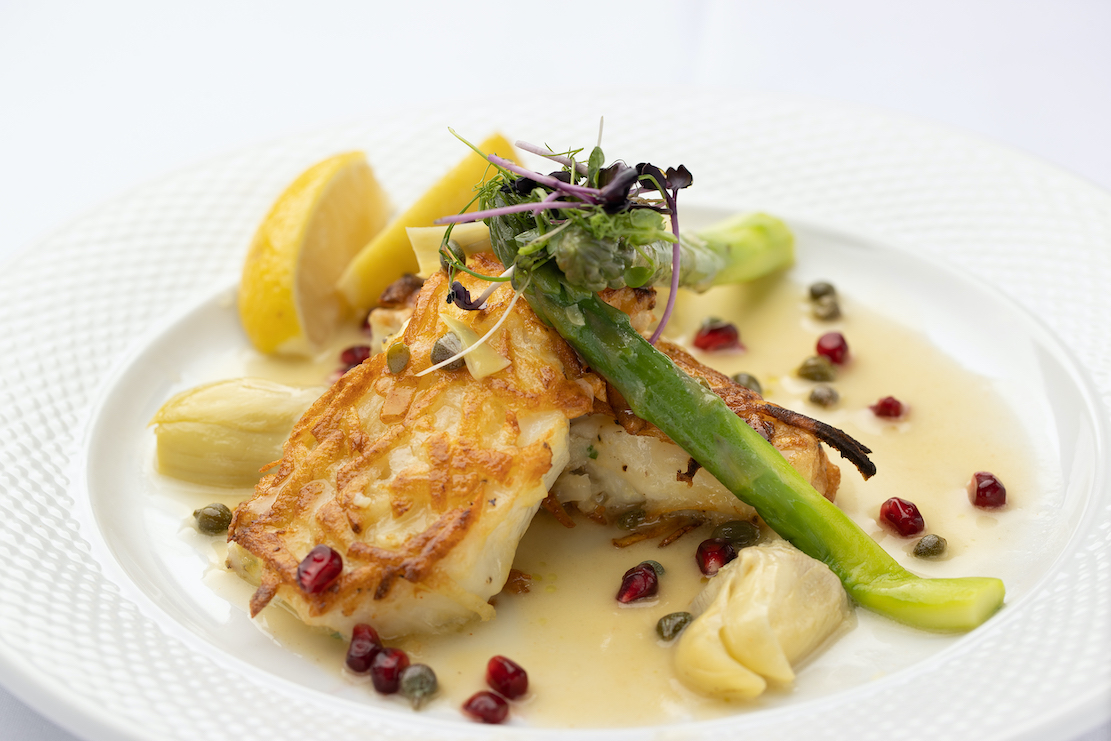 too
a flavorful Dover sole was
perfectly rendered with a tangy lemon and white
wine sauce (market price).
too
a flavorful Dover sole was
perfectly rendered with a tangy lemon and white
wine sauce (market price).
There is chicken scarpariello
on the menu ($35), a dish
that usually contains sausage, but, instead,
you’ll find in the “Il Monello”
both white and dark chicken, potatoes, roasted
peppers and a white wine sauce
($35). Best of all was a bountiful pollo
parmigiana ($34) that takes the basic
ingredients of pounded, breaded
chicken breast with tomato sauce and mozzarella
and plates it as a generous and
attractive circle the size of a pizza (below).
The ingredients are key to this dish,
and more than a match for the far more expensive
veal parm at Carbone’s for
$72.
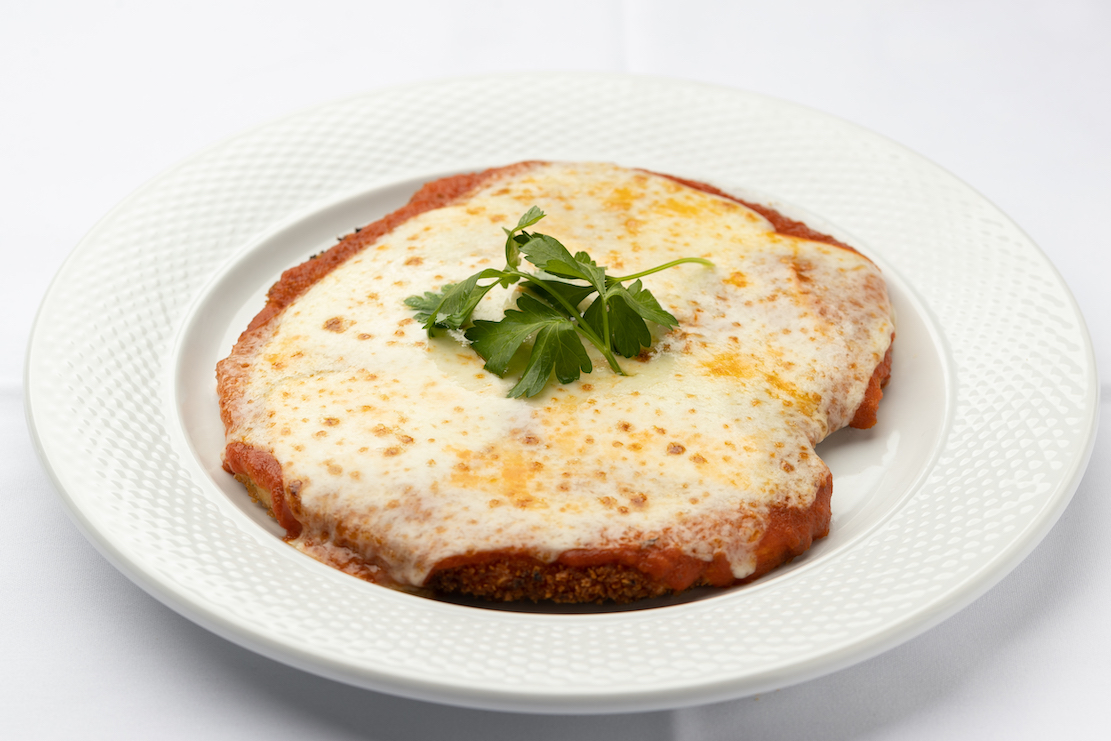 Haxhiaj
also owns the Theater District
Tuscany Steakhouse, so his meat and seafood
suppliers are of the same high
quality, and it shows in the massive bone-in
ribeye we enjoyed ($69). There is
also a bistecca
alla Fiorentina here
($63 per person) under the name “Tuscany
porterhouse.” By the way, the French
fries ($12) are terrific.
Haxhiaj
also owns the Theater District
Tuscany Steakhouse, so his meat and seafood
suppliers are of the same high
quality, and it shows in the massive bone-in
ribeye we enjoyed ($69). There is
also a bistecca
alla Fiorentina here
($63 per person) under the name “Tuscany
porterhouse.” By the way, the French
fries ($12) are terrific.
I do, actually, wish there were more
Tuscan dishes on the menu, like pappa al
pomodoro and pappardelle
con lepre,
and perhaps they will be specials sometimes. One
dish I’m begging them to bring
back from the original Il Monello was
Giovanetti’s ravioli malfatti—“badly made
ravioli”—which has no pasta wrapping
at all, instead consisting of a spinach-ricotta
filling cooked on its own and
lashed with butter.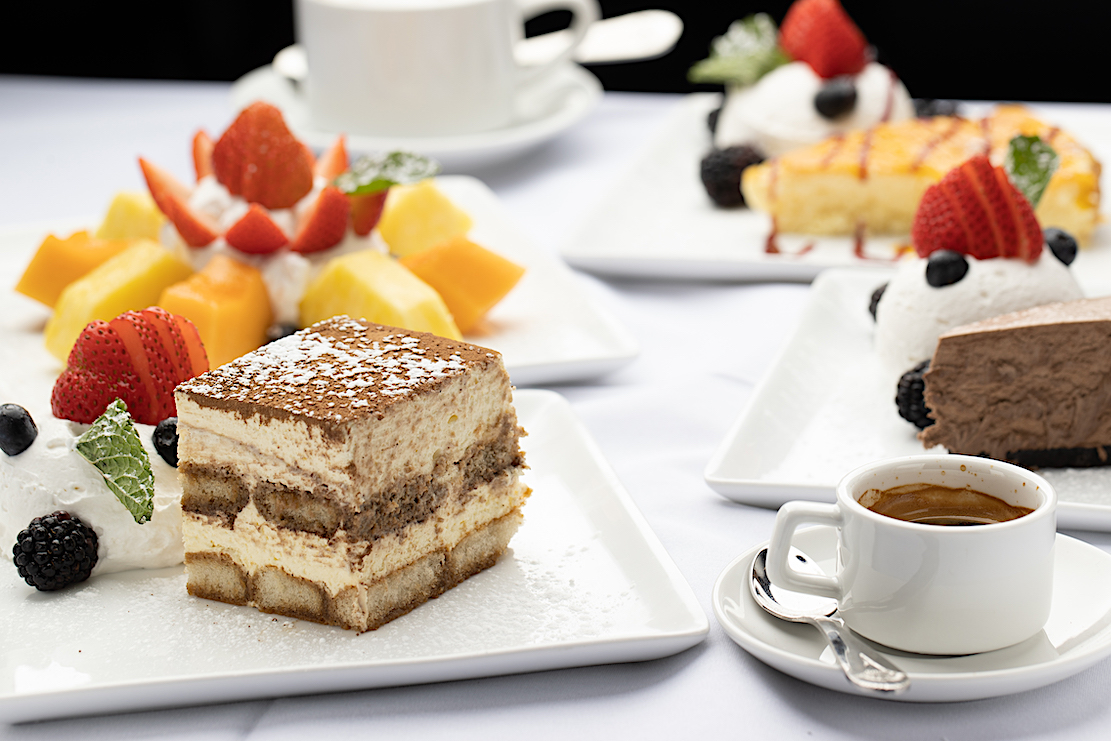
I highly recommend a dessert ($14) or
two at Il Monello, all freshly made, perhaps the
tiramisù or the cheesecake,
and with the fruit platter you get a big dollop
of whipped cream for spooning
onto the dessert plates. It’s a generous
gesture.
But
then, everything at Il Monello is,
including the service. No little rascals here,
just veteran professionals who
aim to please. It’s good to have Il Monello back
and very good to come back to.
Open
nightly for dinner from 4 p.m.
GOING AFTER HARRY LIME
By John Mariani
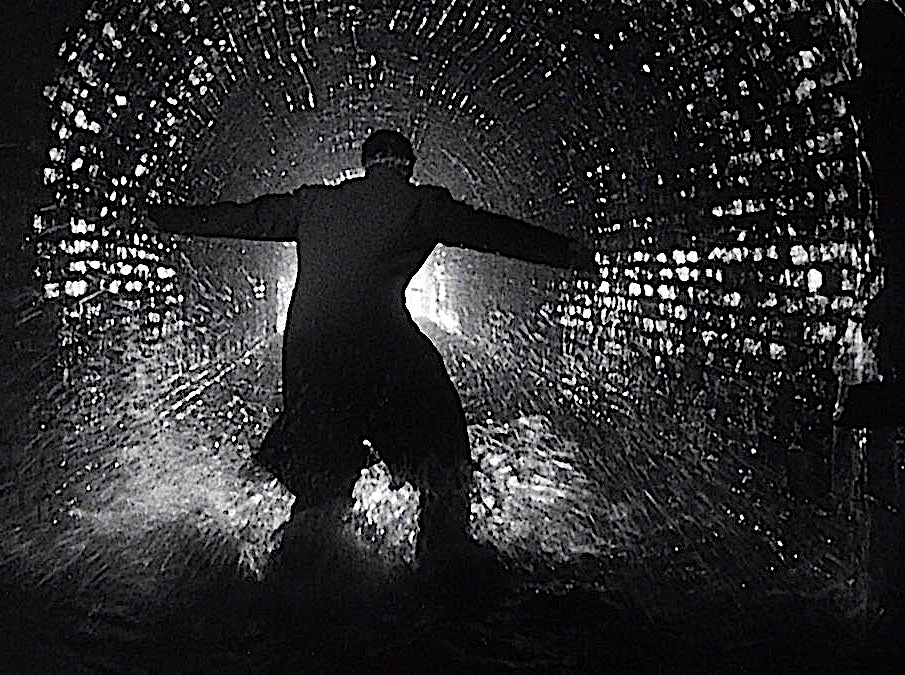
 Katie and
David had both been born in the Bronx, though
she grew up in
the upper middle class section called Pelham
Gardens (left)—her father a district
attorney, her mother a teacher—while David
grew up in a tough, gritty
neighborhood called Castle Hill, where, back
in the 1950s teenage
gangs—Italians, Irish, African-Americans,
Puerto Ricans—would battle over turf
that sometimes amounted to less than a few
square blocks. By the time he’d
become a cop, the entire borough of the Bronx
had acquired a reputation as a
hellhole of violence, burnt-out tenement
buildings and drug houses, which was
only partially true, mainly in the South
Bronx, while most of the North
remained residential, with more park space
than any other borough in New York.
Katie and
David had both been born in the Bronx, though
she grew up in
the upper middle class section called Pelham
Gardens (left)—her father a district
attorney, her mother a teacher—while David
grew up in a tough, gritty
neighborhood called Castle Hill, where, back
in the 1950s teenage
gangs—Italians, Irish, African-Americans,
Puerto Ricans—would battle over turf
that sometimes amounted to less than a few
square blocks. By the time he’d
become a cop, the entire borough of the Bronx
had acquired a reputation as a
hellhole of violence, burnt-out tenement
buildings and drug houses, which was
only partially true, mainly in the South
Bronx, while most of the North
remained residential, with more park space
than any other borough in New York.
David,
who was five-ten and stocky, now with some gray
in his hair and an occasional
three day’s growth of beard, had once had dreams
of going to West Point but was
never invited, so joining the NYPD seemed the
natural trajectory for the son of
a cop. Katie,
meanwhile, went to
Catholic schools, then on to Fordham University,
near the Bronx Zoo and
Botanical Gardens, afterwards becoming a
reporter who moved up from local news
to magazines.
So
the two of them had a great deal in common, but
while her education was of the
highest level, David’s was mostly acquired on
the streets of New York, where he
rose to become lead detective in the section
that investigated the mobs.
Katie
was tall—with heels, taller than David—and very
attractive, with light brown
hair and eyes, with a very slight patrician bump
on her nose, and hips she
wished were just slightly less wide. She had not
married, yet, but she had an
off-and-on relationship with a man David
referred to only as “the lawyer guy,”
a bit of condescension Katie had long ignored.
At the moment the “lawyer guy” was still
in the picture, but the
relationship didn’t seem to be headed any closer
to marriage than it had when
David met Katie three years before. That
didn’t really give David any hope, but he was
content that the status quo let
him dream a little.
*
*
*
The
next day Katie went to the McClure’s
office to see her editor, Alan Dobell, who as
usual had his feet on his desk
with an article manuscript in his lap and a red
pencil in his hand. He was
an old school, daily newspaper kind of
editor, obsessed with deadlines, even though McClure’s was a monthly, so he
could only go into his deadline rant
once a month.
As meticulous about good
writing as much as he was about solid reporting,
Dobell trusted his best writers’
instincts, especially after forcing them to
defend a story proposal he
pretended he had qualms about.
“Think
I got a good story for us,” said Katie, walking
through Dobell’s ever-open door
and sitting down in a swivel chair that had been
squeaking for at least the
past five years.
“So
what’s it gonna cost me?” asked Dobell, his legs
still up on his desk. Katie
tried to remember if she’d ever seen them off
the desk.
“Oh,
I don’t know, a couple of hundred thousand in
expenses,” Katie joked, knowing
that Dobell thought her actual expenses, even
with international travel, had
always been completely reasonable to get
prize-winning stories that panned out
to be way out of the ordinary.
“Well,
maybe I won’t mind this time, unless you end up
getting yourself killed and not
handing in the
story.”
Graham
Greene
“Oh,
believe me, Alan, I try very hard not
to get killed. I would not want to be six feet
under and hear you standing over
my grave bitching about my not handing in the
story.”
“Okay,
so what’ve you got?”
“You
know the movie The Third
Man, right?”
Alan
nodded.
“And
you know Graham Greene wrote the script.”
Another
nod.
“So
you know that Greene had been in the British
Secret Service during the war,
right?”
“Yeah,
he was pals with the British double agent Kim
Philby.” (below)
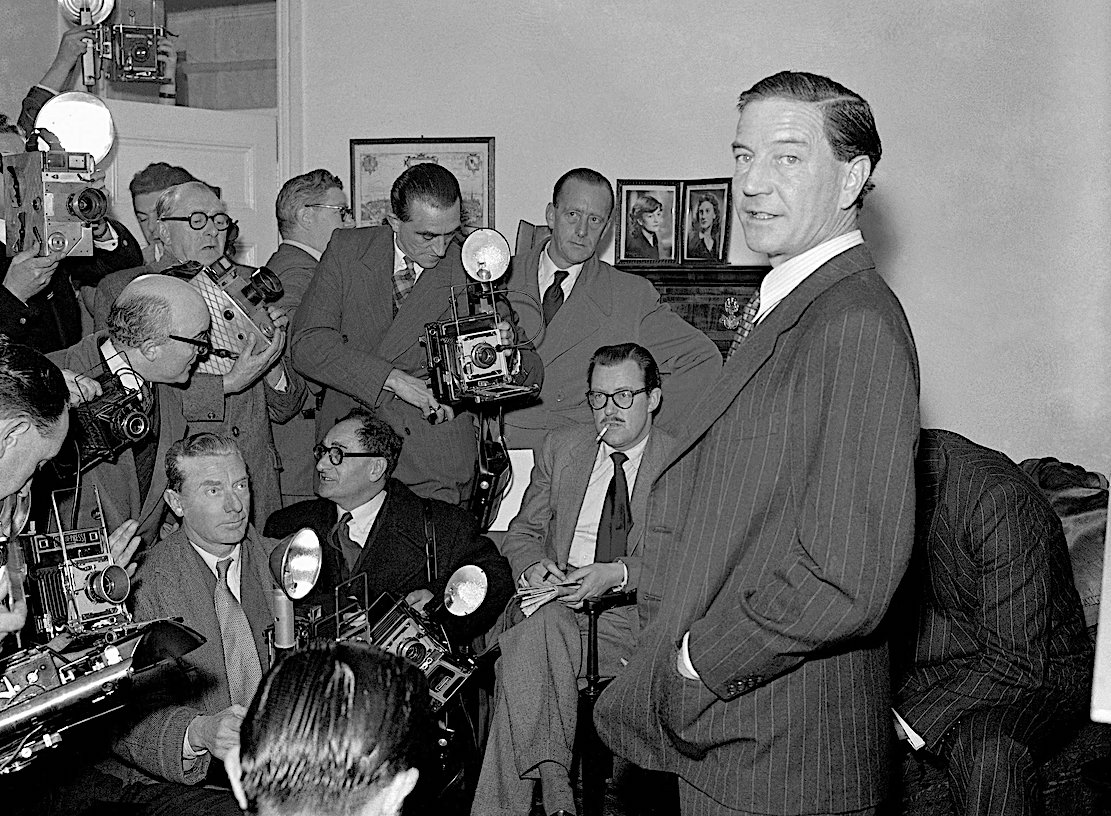 “Exactly.
And from what I’ve read, even after the Brits
caught on to Philby and he
escaped to Russia, Greene always said he was one
of the most fascinating people
he’d ever met.”
“Exactly.
And from what I’ve read, even after the Brits
caught on to Philby and he
escaped to Russia, Greene always said he was one
of the most fascinating people
he’d ever met.”
Dobell
tossed the manuscript on his desk.
“And
you think Philby was the inspiration for Harry
Lime. So
what?
We’re not a literary magazine. That’s
something the New York Review of Books might
publish, maybe The New Yorker.”
“I
realize that,” said Katie, “and I have no idea
if Philby was the inspiration. But somebody
Greene knew must have been.”
“Or
maybe an amalgamation of several people he knew.
Or nobody at all.”
“Very
possibly. But
I’m not interested in just
digging through Greene’s works and letters and
making a reasonable conjecture.”
“You’re
not?” asked Dobell, showing he was losing
interest.
“Nope.
What I want to do is to really dig deep, talk to
people who were involved with
Greene during the war . . .”
“Not
too many of them are likely to be alive.”
“True,
but there have to be some. And
then try
to find out if the most likely suspect is still
alive. See?”
“What
I see,” said Dobell, “is a wild goose chase that
will have you trekking through
the sewers of Vienna looking for a Harry Lime
type who probably died twenty
years ago.”
“But,
if he didn’t die and I can find him, wouldn’t
that be a fabulous story? Because
the guy would have been some sort of criminal
back in the old days and gotten
away with it.”
“Or,
Katie, he could have been swept up by the
British and jailed or by the Russians
and never seen again.” Dobell
drew an
imaginary knife across his throat.
“I
know, I know, but, well, what if I start doing
some digging on my own, and if
it turns out to be a story for the literary
mags, I’ll pitch it to them.”
“And
get paid peanuts for your effort.”
“Hey,
I hear The
New Yorker pays better
than McClure’s.”
“Now
that was bad salesmanship, Katie. But, what the
hell, if you want to do it on
your own time—as long as you keep working on
stories for McClure’s that I’ve already
approved, I won’t stop you.”
“And
if I do find the real Harry Lime living lavishly
somewhere in Vienna or a dacha
in Ukraine, you’ll send me to find him?”
“Big
if, but maybe. I’ve always trusted you before.”
“Great,
thank you, Alan.” Katie got up to leave while
there was still a positive spin
in the air.
“Uh,
isn’t there something else you want to ask me,
Katie?”
Katie
tilted her head and squinted.
“You
mean hiring David Greco to help with my
research?”
“You
know that’s exactly what I mean.”
“Alan,
you know my Capone and Vermeer stories would
never have been as good as they
were without David’s help. But
I’ll be
frank with you. At least at this point I don’t
think I’ll need his help, unless
I get to the point where the story’s going in a
devious or criminal direction. For
the time being I’m just going to be
reading up on Greene and make some phone calls.”
“Listen,
Katie, I know Greco’s been invaluable and I like
the guy. But
as of now, you’re on your own.”
“Actually,
David did say he’d work with me on this without
getting paid.”
“Hmm,
so he thinks
like you too. Okay, go
read up on Graham Greene and huddle somewhere
with Greco and let me know where
it’s going.
But right now I expect you
to go back to your cubicle over there and finish
up the story on that hospital
finance scandal.
When’s that coming in?”
“Soon,
Alan, soon.”
And Katie was gone.
© John Mariani, 2017
❖❖❖
DOMAINE DE LA RIVIÈRE
By GEOFF KALISH

It’s said that
if you want to make a
small fortune in the wine business, start
with a large one. Add to that, “If you want to
start and maintain a boutique winery, be sure to
have another job." With this
second adage in mind I recently met with Marla and
Geoff Bedrosian, owners of
Sonoma County’s critically acclaimed Domaine de la
Rivière, to talk about their
experiences in starting and running a boutique
winery and to taste some of
their recent vintages. The answers to my questions
were provided by Marla Bedrosian,
followed by my own tasting notes on their wines.
How
did you happen to start a
winery?
In the
late 1990s and 2000s we
became California wine enthusiasts and travelled
frequently to Sonoma and Napa
from our home in Westchester County, New York. During
these trips, the personal
connections we made in Sonoma County with the people,
the land and the wine
from the Russian River Valley made us want to become
part of the wine country
community, and in 2011 we purchased a 22-acre ranch,
planted to 11 acres of
Pinot Noir, in the Russian River town of Windsor and
we became grape growers,
selling what we made. On one of these visits we met
Kale Anderson, our
winemaker, and after six harvests under our belts we
decided to make wine,
focusing on production of our Pinot Noir and
Chardonnay from the Middle Reach
neighborhood.
What
are your backgrounds as
relates to the winery?
I’ve
spent 25 years in the
hospitality industry, conducting corporate group sales
for an international
hotel company, and now run the day-to-day operations
of the winery,
particularly sales and marketing. Geoff is involved in
investment banking and
had the opportunity to sell a number of vineyard
companies, so he became
familiar with the ins and out of the business aspects
of a winery. Duff, our
oldest son, has been working at a real estate
investment management company
since his graduation from Cornell University’s School
of Hotel Administration.
(Both Geoff and Duff are continuing to work at their
jobs in addition to their
involvement in the winery.) Kale Anderson, the
winemaker, a graduate of the
Viticulture and Enology section of UC Davis, has
worked at a number of wineries
over the past few years, most recently Pahlmeyer.
 What is your
basic philosophy in
making wine?
What is your
basic philosophy in
making wine?
We
believe that each wine has a
story of its own. Our winemaker patiently orchestrates
the development of the
fruit after it’s off the vine and gently guides it
through the craft of wine
making. By marrying modern tools and equipment with
the traditional practices
of Burgundy, the unique characteristics of the fruit
with the terroir in which
it grew creates authentic artisanal wines.
How
much wine are you producing?
One
thousand cases annually,
which is made at Grand Cru Custom Crush in Windsor,
with all of our grapes sourced
from ultra-premium vineyards in the Middle Reach
Neighborhood of the Russian
River Valley and vinified to have a Burgundian style.
Where
or how can I buy it?
In
addition to sales from our
tasting facility at Grand Cru Custom Crush (1200
American Way, Windsor, CA), our wines are sold
directly to individuals and
corporate customers in 45 states. In addition, our
wines are available at
restaurants in Sonoma, Napa, the Bay Area, Los
Angeles, San Luis Obispo, Chicago,
Connecticut and Arizona.
What
are your plans for the
future of the winery?
Our
immediate plans are to
continue making the highest quality wine from grapes
grown in the Middle Reach
area of Sonoma, and to continue to incorporate our two
sons Duff (interested in
winemaking) and Zak (interested in marketing) into the
business. Our concierge
approach to customer service is an important
differentiator that we will
continue to develop since it serves as the foundation
on which our future will
grow.
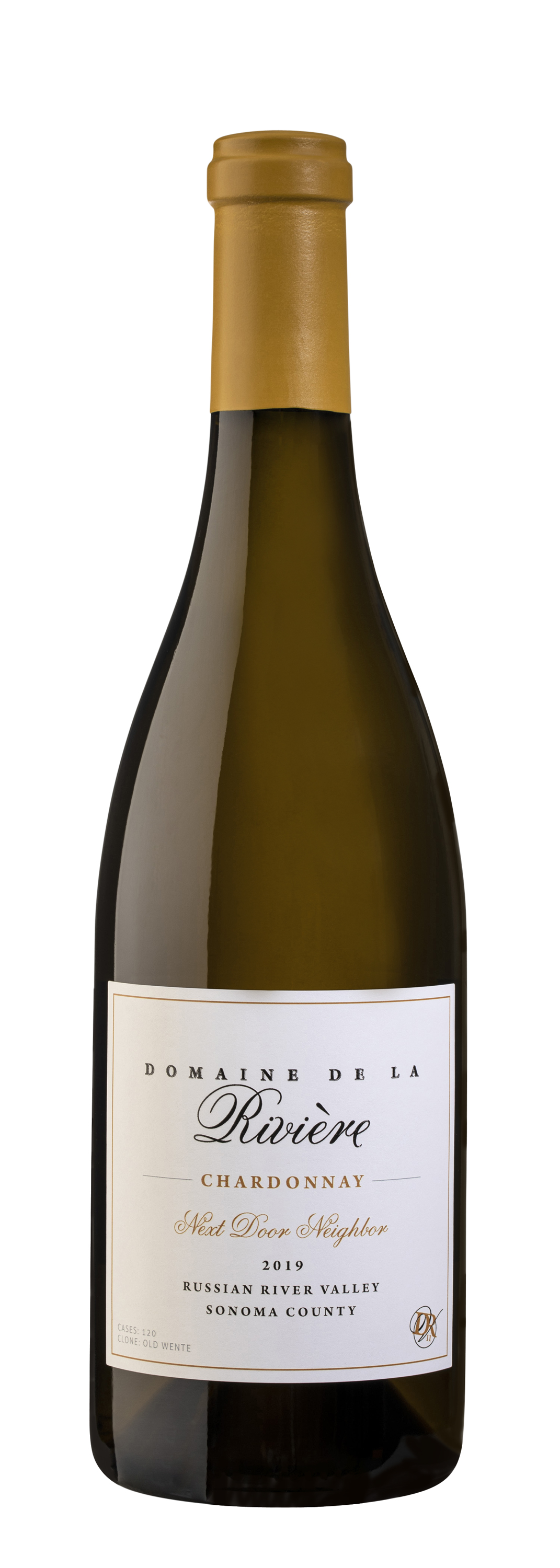 Current Vintage Wines
Current Vintage Wines
2021
Soshana Rosé
of Pinot Noir ($36)—Named for the Bedrosians’
daughter, this wine from early
harvested Russian River grapes shows a very fruity
bouquet and taste of pears
and peaches with a surprisingly crisp finish. It makes
a great aperitif as well
as an excellent choice to serve with 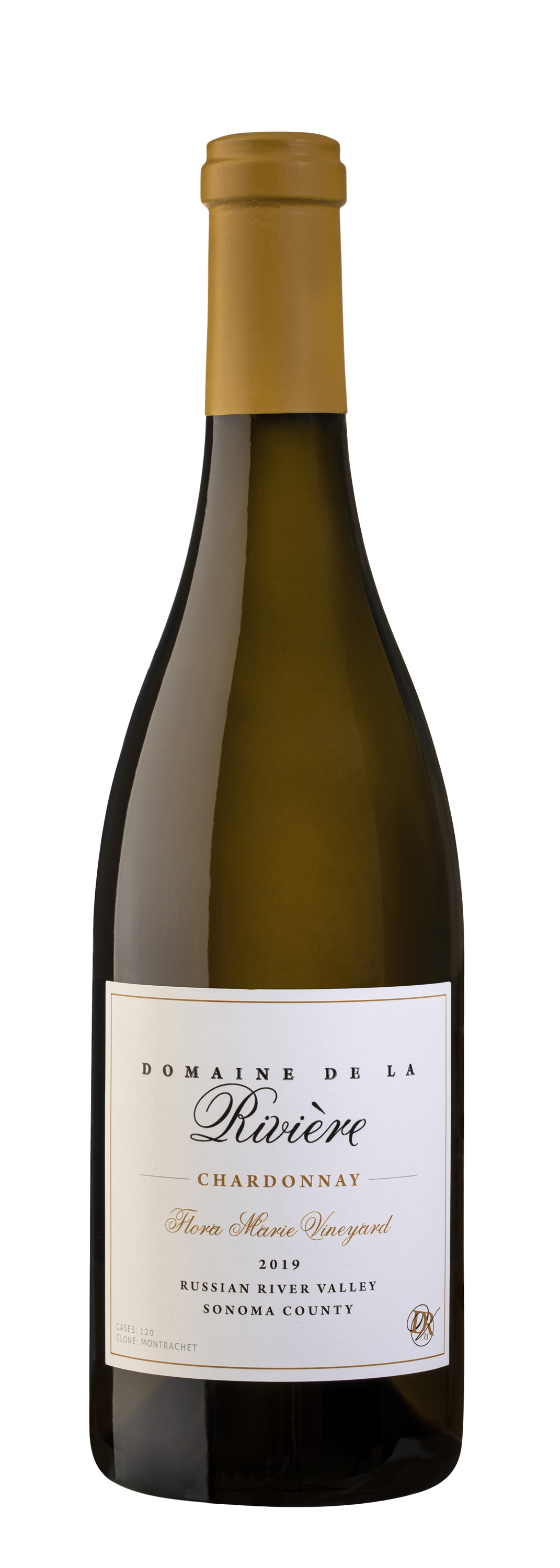 spicy Asian fare.
spicy Asian fare.
2019
Next Door Neighbor Chardonnay
($62)—Following fermentation, this wine spent 11
months in oak (42% New French)
and exhibits a bouquet and taste of ripe apples and
pears with undertones of
vanilla. Try it with shrimp, lobster or mild fish like
branzino.
2019
Flora Marie Vineyard Chardonnay
($70)—This white is reminiscent of a Premiere Cru
Chablis, with a dry, rather
austere taste of pears and apples and a crisp finish
loaded with notes of
brioche—a perfect match for clams and oysters on the
half-shell as well as
grilled shrimp
2020
Domaine de la Riviere Middle
Reach Village Pinot Noir ($70)—This 100% Pinot Noir
was made from grapes grown
on steep slopes in gravely, sandy loam soil. Following
fermentation, it was aged
for 11 months in oak barrels (65% New French oak) and
shows a bouquet and taste
similar to a top-flight Pommard, with a concentrated
flavor of cherries, plums,
and cranberries, and hints of vanilla in its finish.
It’s ideal to accompany
baked chicken, duck, grilled tuna and even swordfish.

Dr. Geoff Kalish writes about wine for several publications. He lives in Mount Kisco, NY.
❖❖❖

WHATEVER HAPPENED TO
PUTTING FILES IN LAYER CAKES?
The TSA
reports several
incidents of passengers at US airports trying to
sneak guns and drugs on planes by
using food as cover. On Dec. 22, officers extracted
parts of
a disassembled handgun from two jars of Jif peanut
butter. Which is really dumb
since peanut products are not allowed on
planes on 60 airlines in any case. . . . A gun was
found jammed inside a raw chicken
at a TSA security checkpoint, and just before
Halloween a traveler tried to hide
12,000 blue pills of suspected fentanyl inside boxes
and sleeves of SweeTarts,
Skittles and Whoppers.
❖❖❖
Any of John Mariani's books below may be ordered from amazon.com.
 The Hound in Heaven
(21st Century Lion Books) is a novella, and
for anyone who loves dogs, Christmas, romance,
inspiration, even the supernatural, I hope you'll find
this to be a treasured favorite. The story
concerns how, after a New England teacher, his wife and
their two daughters adopt a stray puppy found in their
barn in northern Maine, their lives seem full of promise.
But when tragedy strikes, their wonderful dog Lazarus and
the spirit of Christmas are the only things that may bring
his master back from the edge of despair.
The Hound in Heaven
(21st Century Lion Books) is a novella, and
for anyone who loves dogs, Christmas, romance,
inspiration, even the supernatural, I hope you'll find
this to be a treasured favorite. The story
concerns how, after a New England teacher, his wife and
their two daughters adopt a stray puppy found in their
barn in northern Maine, their lives seem full of promise.
But when tragedy strikes, their wonderful dog Lazarus and
the spirit of Christmas are the only things that may bring
his master back from the edge of despair. WATCH THE VIDEO!
“What a huge surprise turn this story took! I was completely stunned! I truly enjoyed this book and its message.” – Actress Ali MacGraw
“He had me at Page One. The amount of heart, human insight, soul searching, and deft literary strength that John Mariani pours into this airtight novella is vertigo-inducing. Perhaps ‘wow’ would be the best comment.” – James Dalessandro, author of Bohemian Heart and 1906.
“John Mariani’s Hound in Heaven starts with a well-painted portrayal of an American family, along with the requisite dog. A surprise event flips the action of the novel and captures us for a voyage leading to a hopeful and heart-warming message. A page turning, one sitting read, it’s the perfect antidote for the winter and promotion of holiday celebration.” – Ann Pearlman, author of The Christmas Cookie Club and A Gift for my Sister.
“John Mariani’s concise, achingly beautiful novella pulls a literary rabbit out of a hat – a mash-up of the cosmic and the intimate, the tragic and the heart-warming – a Christmas tale for all ages, and all faiths. Read it to your children, read it to yourself… but read it. Early and often. Highly recommended.” – Jay Bonansinga, New York Times bestselling author of Pinkerton’s War, The Sinking of The Eastland, and The Walking Dead: The Road To Woodbury.
“Amazing things happen when you open your heart to an animal. The Hound in Heaven delivers a powerful story of healing that is forged in the spiritual relationship between a man and his best friend. The book brings a message of hope that can enrich our images of family, love, and loss.” – Dr. Barbara Royal, author of The Royal Treatment.
 |
The Encyclopedia of American Food and Drink by John F. Mariani (Bloomsbury USA, $35) Modesty forbids me to praise my own new book, but let me proudly say that it is an extensive revision of the 4th edition that appeared more than a decade ago, before locavores, molecular cuisine, modernist cuisine, the Food Network and so much more, now included. Word origins have been completely updated, as have per capita consumption and production stats. Most important, for the first time since publication in the 1980s, the book includes more than 100 biographies of Americans who have changed the way we cook, eat and drink -- from Fannie Farmer and Julia Child to Robert Mondavi and Thomas Keller. "This book is amazing! It has entries for everything from `abalone' to `zwieback,' plus more than 500 recipes for classic American dishes and drinks."--Devra First, The Boston Globe. "Much needed in any kitchen library."--Bon Appetit. |
"Eating Italian will never be the same after reading John Mariani's entertaining and savory gastronomical history of the cuisine of Italy and how it won over appetites worldwide. . . . This book is such a tasteful narrative that it will literally make you hungry for Italian food and arouse your appetite for gastronomical history."--Don Oldenburg, USA Today. "Italian
restaurants--some good, some glitzy--far
outnumber their French rivals. Many of
these establishments are zestfully described
in How Italian Food Conquered the World, an
entertaining and fact-filled chronicle by
food-and-wine correspondent John F.
Mariani."--Aram Bakshian Jr., Wall Street
Journal.
"Equal parts
history, sociology, gastronomy, and just
plain fun, How Italian Food Conquered the
World tells the captivating and delicious
story of the (let's face it) everybody's
favorite cuisine with clarity, verve and
more than one surprise."--Colman Andrews,
editorial director of The Daily
Meal.com. "A fantastic and fascinating
read, covering everything from the influence
of Venice's spice trade to the impact of
Italian immigrants in America and the
evolution of alta cucina. This book will
serve as a terrific resource to anyone
interested in the real story of Italian
food."--Mary Ann Esposito, host of PBS-TV's
Ciao
Italia. "John Mariani has written the
definitive history of how Italians won their
way into our hearts, minds, and
stomachs. It's a story of pleasure over
pomp and taste over technique."--Danny Meyer,
owner of NYC restaurants Union Square
Cafe, The Modern, and Maialino.
|
 |
 |
 |
 |
 |
 |
MARIANI'S VIRTUAL GOURMET
NEWSLETTER is published weekly. Publisher: John Mariani. Editor: Walter Bagley. Contributing Writers: Christopher
Mariani, Misha Mariani, John A. Curtas, Gerry Dawes, Geoff Kalish.
Contributing
Photographer: Galina Dargery. Technical
Advisor: Gerry
McLoughlin.
If you wish to subscribe to this
newsletter, please click here: http://www.johnmariani.com/subscribe/index.html
© copyright John Mariani 2023
